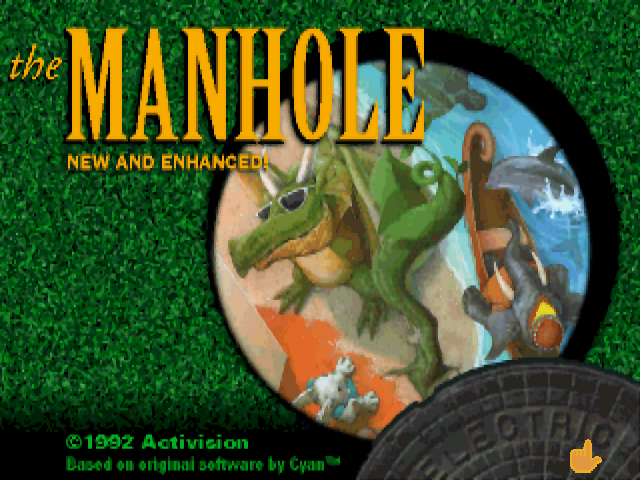
In 1989, it earned the distinction of being the first game ever published as a CD-ROM. In the 1990s, the original Apple Macintosh HyperCard version started receiving ports to other platforms, including MS-DOS, Windows, and most recently, the iPhone.
The Manhole was followed by a Spiritual Successor IN SPACE, Cosmic Osmo.
This game provides examples of:
- Adaptation Expansion: The "New and Enhanced" version added a new underwater cavern area that let out underneath the elephant's boat. Unfortunately, the "Masterpiece" edition was only based on the original, and didn't include this area.
- Art-Shifted Sequel: The art style of the characters in "Masterpiece Edition" seems intended to give it the look of being inside in a vintage storybook.
- Can't Take Criticism: Hamlet Pig will get irritated and refuse to let you pass if you say you don't like his (non-sequitur, randomly generated) poem. The rhinoceros lady he's guarding (presumably his superior) will tell you to just humour him whenever you speak to him because "his brain is very small".
- Chess Motifs: The flamingo's domain.
- Edutainment Game: Very mild educational elements, such as a book of the alphabet and a few lines of dialogue written in both French and English.
- Elevator Gag: The "New and Enhanced" edition added some on the floors between the sunken ship and the walrus's island.
- Featureless Protagonist: The player character is implied to be a kid, and that's pretty much the only thing you know about them.
- In fact they seem to be just one of many, if the walrus's complaint letter to the rabbit is anything to go by.
- The Guards Must Be Crazy: In "Masterpiece Edition" the stairs to the top of the tower are guarded by a pig knight. Whether you can go past depends on whether you praise his terrible poetry or not.
- Macro Zone: And Macro Zones within Macro Zones. You can sail a tiny boat around the teacup of a rabbit who lives inside a fire hydrant.
- Mythology Gag: In the Masterpiece Edition, the rhinoceros at the top of the tower tells you she was a flamingo in a previous life, since you met a flamingo there in the original version of the game.
- Non Sequitur Environment: By climbing a beanstalk, you can find a forest above the clouds or a tropical island under the eponymous manhole; a tower sitting in the middle of the forest turns out to be a rook in a giant chess set bobbing in an underground canal, but only when you reach the top; a perfectly ordinary elevator can open in a sunken ship; a wrong turn in one of the canals can take you through the teacup of a rabbit living in a fire hydrant across from the manhole...
- No Plot? No Problem!: The game has no plot or storyline to speak of, just wandering around a bizarre world to see what there is to see.
- Our Dragons Are Different: This dragon is a laid-back dude in Cool Shades.
- Portal Picture: There's a picture of a dragon that will take the player to Mr. Dragon's lair...uh, crib. Also in the ship is a picture of a boat, where, after making it sink, you can teleport to the base of the beanstalk.
- Product Placement:
- Mr. Rabbit keeps a collection of books the player's encouraged to read in real life, including Alice's Adventures in Wonderland, The Wind in the Willows, The Lion, the Witch, and the Wardrobe, and Winnie the Pooh.
- One of the pig's random poetry lines in "Masterpiece Edition" is a sales plug for Pirelli Tires.
- Shout-Out: The whooshes of a passing spaceship form the five-note motif from Close Encounters of the Third Kind.
- In the CD-ROM version, clicking on the TV in the house plays you a trailer for Myst.
- Super Not-Drowning Skills: The bottom of the game map is underwater. You can stay down there as long as you want.
- Take That!: On a shelf of children's books with pop-up descriptions of what they're about is a textbook called "Metaphors of Intercultural Philosophy". note "This book isn't about anything."
- Updated Re-release: The "New and Enhanced" edition, the "Masterpiece" edition...
- Warp Whistle: Mr. Dragon's TV set. You warp to a different place through it depending on what channel you pick, even back to the title screen.
- Welcome to Corneria: Most of the characters have only a couple of lines of dialogue (some only have one) and they'll just repeat themselves if you try to talk to them further.
- Wide-Open Sandbox: One designed for kids, in that there's no enemies to fight or treasure to hoard. Just looking around poking in every nook and cranny to see if something fun happens.
- World of Chaos: There's no rhyme or reason between how the game's areas connect at all. But then, that's part of the fun.
